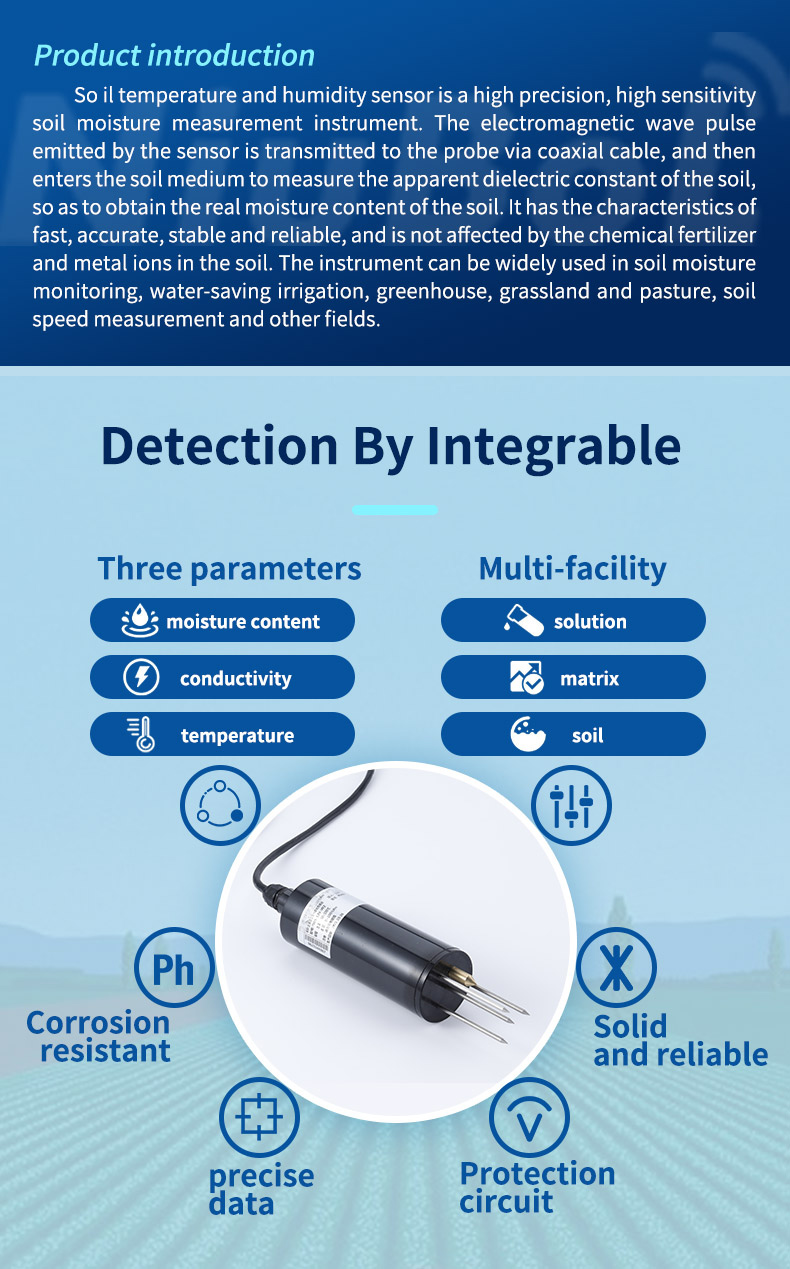

— Blogs —
—Products—
 Consumer hotline +8618073152920
Consumer hotline +8618073152920 WhatsApp:+8615367865107
Address:Room 102, District D, Houhu Industrial Park, Yuelu District, Changsha City, Hunan Province, China
Product knowledge
Time:2022-05-10 20:22:18 Popularity:2145
The soil temperature sensor is a soil temperature sensor that can monitor the temperature of soil, atmosphere and water for experiments and scientific research. Soil temperature, referred to as ground temperature, is a general term for surface temperature and ground temperature. The soil temperature is closely related to the growth and development of crops, the decomposition of fertilizers and the accumulation of organic matter, and is an important environmental factor in agricultural production.
Soil temperature is also an extremely important factor in the formation of microclimate, so the measurement and research of soil temperature is an important content in microclimate observation and agro-meteorological observation. The rise and fall of soil temperature is mainly determined by the magnitude and direction of soil heat flux, but also related to soil thermal properties such as soil volume heat capacity, thermal conductivity, density, specific heat and porosity, and soil water content. For non-level surfaces, it is also related to the location and size of the slope.

So how does the soil temperature sensor work?
In fact, many friends want to know the principle of this kind of sensor when they see this. In fact, it is similar to the principle of ordinary temperature sensor. It is designed by the principle of thermistor. However, compared with the conventional temperature sensor, the soil temperature sensor has The sealed housing structure with better durability ensures that the sensor can keep working when buried deep underground.
The soil moisture sensor is to monitor the humidity of the soil, and its hardware control circuit is buried in the soil moisture sensor at the root of the crop to monitor the moisture of the root soil. It is transmitted to the main controller, and the main controller determines the control state. If the humidity is too high, the irrigation will be stopped; if the humidity is too low, the solenoid valve connected to the water source will be controlled by photoelectric isolation and relay. The system also has a fault alarm function. The main controller communicates with the upper computer through the communication interface, which can monitor the system running status in real time or analyze the historical data.
The soil moisture sensor is to determine the amount of moisture in the soil to determine the moisture level of the soil. When the soil moisture sensor probe is suspended, the base of the triode is in an open circuit state, and the cut-off output of the triode is 0; when it is inserted into the soil, due to the different moisture content in the soil, the resistance value of the soil is different, and the base of the triode provides the magnitude of the change. On-current, the on-current from the collector to the emitter of the transistor is controlled by the base, and is converted into a voltage after passing through the pull-down resistor of the emitter.
Related recommendations
Sensors & Weather Stations Catalog
Agriculture Sensors and Weather Stations Catalog-NiuBoL.pdf
Weather Stations Catalog-NiuBoL.pdf
Related products
 Combined air temperature and relative humidity sensor
Combined air temperature and relative humidity sensor Soil Moisture Temperature sensor for irrigation
Soil Moisture Temperature sensor for irrigation Soil pH sensor RS485 soil Testing instrument soil ph meter for agriculture
Soil pH sensor RS485 soil Testing instrument soil ph meter for agriculture Wind Speed sensor Output Modbus/RS485/Analog/0-5V/4-20mA
Wind Speed sensor Output Modbus/RS485/Analog/0-5V/4-20mA Tipping bucket rain gauge for weather monitoring auto rainfall sensor RS485/Outdoor/stainless steel
Tipping bucket rain gauge for weather monitoring auto rainfall sensor RS485/Outdoor/stainless steel Pyranometer Solar Radiation Sensor 4-20mA/RS485
Pyranometer Solar Radiation Sensor 4-20mA/RS485
Screenshot, WhatsApp to identify the QR code
WhatsApp number:+8615367865107
(Click on WhatsApp to copy and add friends)
